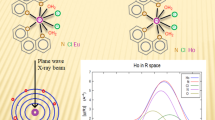Summary
The absorption spectra of hematein-aluminium solutions have been recorded at various concentrations and pH values; the solutions were prepared using analytically pure hematein and potassium alum as aluminium source. In aqueous solution, four different hematein-aluminium complexes could be distinguished by absorption spectroscopy. In weakly acidic media we observed the violet 1:1 and 1:2 complexes HmAl⊕ (VII) and HmAl sup3⊕inf2 (VIII), and in strongly acidic solution the red 1:1 complex HmAl2⊕ (IX). Whereas, in weakly alkaline solution the blue 1:1 complex HmAl0 (X) was detected. By change of the pH value the complexes were mutual interconverted. The dye complexes were characterized by their absorption spectra and molar extinction coefficients. We have stained HeLa cells with the complex solutions under different experimental conditions. In all cases the nuclear staining was intense whereas the staining of the cytoplasm was weak. The microspectra of the stained nuclei were recorded and compared with the absorption spectra of the complexes in solution. Thus it was possible to identify the bound dye species. After staining in acidic media, the cells were red to redviolet depending on the reaction conditions. The three cationic dye species VII, VIII, and IX were bound in varying amounts. After blueing in weakly acidic media or in water, only the violet dye complex VII was detected whereas, after blueing in weakly alkaline media, only the blue complex X has been observed. Enzymatic digestion experiments have shown that the dye complexes in the nuclei were bound to DNA while those in the cytoplasm and nucleoli were bound to RNA. The binding between the dye complexes and the nucleic acids is discussed.
Similar content being viewed by others
References
Arshid FM, Connelly RF, Desai JN, Fulton RG, Giles Ch, Kefalas JC (1954) A study of certain natural dyes. II — The structure of the metallic lakes of brazilwood and logwood colouring matters. J Soc Dyers Colour 70:402–412
Asmus E, Altmann HJ, Thomasz E (1966) Photometrische Bestimmung von Zinn mit Hämatein. Z Anal Chem 216:3–13
Baker JR (1962) Experiments on action of mordants. 2. Aluminium-haemateine. Quart J Microsc Sci 103:493–517
Bettinger Ch, Zimmermann HW (1991) New investigations on hematoxylin, hematein, and hematein-aluminium-complexes. I. Spectroscopic and physico-chemical properties of hematoxylin and hematein. Histochemistry 95:279–288
Harms H (1957) Handbuch der Farbstoffe für die Mikroskopie, Teil II, 2. Lieferung. Staufen-Verlag, Kamp-Lintfort
Lalor GC (1962) Studies on haematoxylin and haematein, the colouring principles of logwood. III — Fading of haematein in aqueous acidic solutions. J Soc Dyers Colour 78:549–551
Lalor GC, Martin SL (1959) Studies on haematoxylin and haematein, the colouring principles of logwood. II — Behaviour in aqueous solutions at varying pH, and the pK values. J Soc Dyers Colour 75:517–521
Lillie RD (1965) Histopathologic technic and practical histochemistry, 3rd edn. McGraw-Hill, New York
Marshall PN, Galbraith W, Bacus JW (1979) Studies on Papanicolaou Staining. II Quantitation of dye components bound to cervical cells. Analyt Qant Cytol 1:169–178
Marshall PN, Horobin RW (1973) The mechanism of action of mordant dyes — A study using preformed metal complexes. Histochemie 35:361–371
Michaelis M (1931) Der Acetat-Veronal-Puffer. Biochem Z 234:139–141
Pauluhn J, Naujok A, Zimmermann HW (1980) Über die quantitative fluorometrische Bestimmung von DNA mit Ethidiumbromid in der Zelle und die Konstanz der Quantenausbeute des Ethidium-DNA-Komplexes im biologischen Milieu. Z Naturforsch 35c:585–598
Puchtler H, Meloan SN, Waldrop FS (1986) Application of current chemical concepts to metal-hematein and-brazilein stains. Histochemistry 85:353–364
Romeis B (1968) Mikroskopische Technik. Oldenburg Verlag, München
Zipfel E, Grezes JR, Naujok A, Seifert W, Wittekind DH, Zimmermann HW (1984) Über Romanowsky-Farbstoffe und den Romanowsky-Giemsa-Effekt. 3. Mitteilung: Mikrospektralphotometrische Untersuchung der Romanowsky-Giemsa-Färbung. Spektroskopischer Nachweis eines DNA — Azur B — Eosin Y — Komplexes, der den Romanowsky-Giemsa-Effekt verursacht. Histochemistry 81:337–351
Author information
Authors and Affiliations
Rights and permissions
About this article
Cite this article
Bettinger, C., Zimmermann, H.W. New investigations on hematoxylin, hematein, and hematein-aluminium complexes. Histochemistry 96, 215–228 (1991). https://doi.org/10.1007/BF00271540
Accepted:
Issue Date:
DOI: https://doi.org/10.1007/BF00271540



